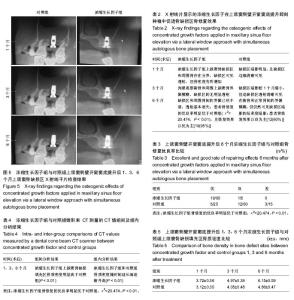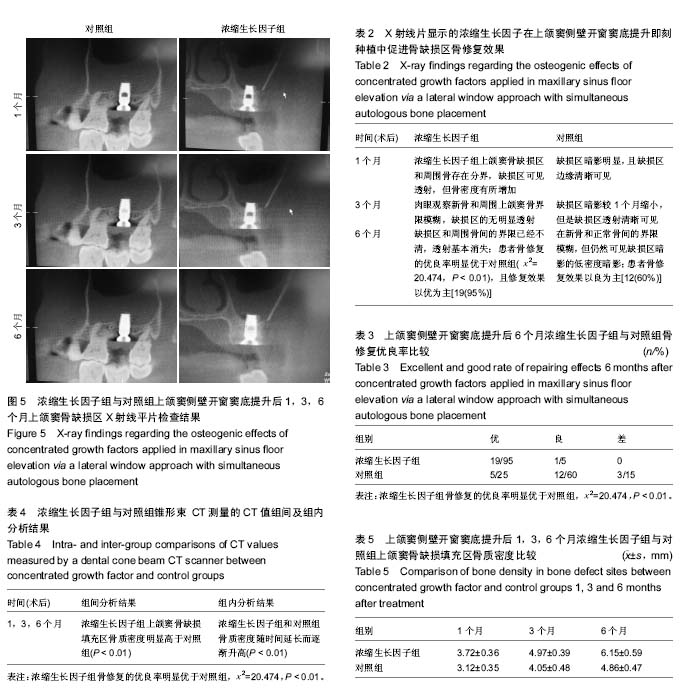| [1] |
Wang Jing, Xiong Shan, Cao Jin, Feng Linwei, Wang Xin.
Role and mechanism of interleukin-3 in bone metabolism
[J]. Chinese Journal of Tissue Engineering Research, 2022, 26(8): 1260-1265.
|
| [2] |
Zhang Jianguo, Chen Chen, Hu Fengling, Huang Daoyu, Song Liang.
Design and biomechanical properties of dental implant pore structure based on three-dimensional finite element analysis
[J]. Chinese Journal of Tissue Engineering Research, 2022, 26(4): 585-590.
|
| [3] |
Wei Zhoudan, Li Wenjin, Zhu Li, Wang Yu, Zhao Jiaoyang, Chen Yanan, Guo Dong, Hao Min.
Platelet-rich fibrin as a material for alveolar ridge preservation significantly reduces the resorption of alveolar bone height and width after tooth extraction: a meta-analysis
[J]. Chinese Journal of Tissue Engineering Research, 2022, 26(4): 643-648.
|
| [4] |
Luo Di, Liang Xuezhen, Liu Jinbao, Li Jiacheng, Yan Bozhao, Xu Bo, Li Gang.
Difference in osteogenesis- and angiogenesis-related protein expression in femoral head samples from patients with femoral head necrosis of different etiologies
[J]. Chinese Journal of Tissue Engineering Research, 2022, 26(11): 1641-1647.
|
| [5] |
Zhou Yi, Liu Xiaoyan, Xiang Bingyan.
Application advantages of concentrated growth factors in the field of tissue repair and regeneration
[J]. Chinese Journal of Tissue Engineering Research, 2022, 26(10): 1631-1640.
|
| [6] |
Ma Zhijie, Li Jingyu, Cao Fang, Liu Rong, Zhao Dewei.
Influencing factors and biological property of novel biomedical materials: porous silicon carbide coated with bioactive tantalum
[J]. Chinese Journal of Tissue Engineering Research, 2021, 25(4): 558-563.
|
| [7] |
Cheng Jun, Tan Jun, Zhao Yun, Cheng Fangdong, Shi Guojia.
Effect of thrombin concentration on the prevention of postoperative cerebrospinal leakage by fibrin glue
[J]. Chinese Journal of Tissue Engineering Research, 2021, 25(4): 570-575.
|
| [8] |
Shi Xiaoxiu, Mao Shilong, Liu Yang, Ma Xingshuang, Luo Yanfeng.
Comparison of tantalum and titanium (alloy) as orthopedic materials: physical and chemical indexes, antibacterial and osteogenic ability
[J]. Chinese Journal of Tissue Engineering Research, 2021, 25(4): 593-599.
|
| [9] |
Chen Junyi, Wang Ning, Peng Chengfei, Zhu Lunjing, Duan Jiangtao, Wang Ye, Bei Chaoyong.
Decalcified bone matrix and lentivirus-mediated silencing of P75 neurotrophin receptor transfected bone marrow mesenchymal stem cells to construct tissue-engineered bone
[J]. Chinese Journal of Tissue Engineering Research, 2021, 25(4): 510-515.
|
| [10] |
Su Chengli, Zhu Songsong, Li Yunfeng.
Application of transport distraction osteogenesis in reconstruction of mandibular segmental defects
[J]. Chinese Journal of Tissue Engineering Research, 2021, 25(35): 5604-5609.
|
| [11] |
Lu Haiping, Lang Xuemei, Cao Jin, Ma Yaping, Xiao Yin, Wang Xin.
Role of calcium ions in bone repair and osteogenesis
[J]. Chinese Journal of Tissue Engineering Research, 2021, 25(35): 5702-5708.
|
| [12] |
Shi Qianhui, Wu Chao, Zhou Qian, Qi Yuhan, Huo Hua, Liao Jian.
Transalveolar sinus floor elevation with or without grafting materials: a meta-analysis
[J]. Chinese Journal of Tissue Engineering Research, 2021, 25(34): 5570-5576.
|
| [13] |
Xiao Deli, Sun Yinzhe, Cui Cheng, Liu Bo.
Preparation and degradation properties of concentrated growth factor fibrin membrane
[J]. Chinese Journal of Tissue Engineering Research, 2021, 25(34): 5413-5419.
|
| [14] |
Huang Minling, Lu Zhaoqi, Shen Zhen, Lin Haixiong, Feng Junjie, Huang Feng, Jiang Ziwei, Cai Qunbin.
Effects of total flavone of Rhizoma Drynariae on the coupling of angiogenesis and osteogenesis in bone remodeling through notch signaling pathway
[J]. Chinese Journal of Tissue Engineering Research, 2021, 25(32): 5116-5122.
|
| [15] |
Liu Lei, Di Haiping, Guo Haina, Cao Dayong, Niu Xihua, Xia Chengde.
Changes in biological characteristics of platelet-rich fibrin by freeze-drying technology
[J]. Chinese Journal of Tissue Engineering Research, 2021, 25(31): 4995-4999.
|

